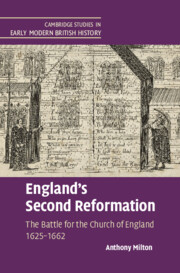Book contents
- England’s Second Reformation
- Cambridge Studies in Early Modern British History
- England’s Second Reformation
- Copyright page
- Dedication
- Contents
- Acknowledgements
- Abbreviations
- Introduction
- Chapter 1 An Unresolved Reformation
- Chapter 2 Situating the Laudian Reformation
- Chapter 3 Responses to the Laudian Reformation
- Chapter 4 The Abortive Reformation, 1640–1642
- Chapter 5 The End of Episcopalian Reformation
- Chapter 6 Reformation by Negotiation
- Chapter 7 The Westminster Reformation and the Parliamentarian Church of England
- Chapter 8 The Royalist Church of England, 1642–1649
- Chapter 9 Alternative Reformations, 1649–1653
- Chapter 10 The Cromwellian Church
- Chapter 11 Episcopalian Royalism in the 1650s
- Chapter 12 Failed Reformations, 1659–1661
- Chapter 13 The End of Comprehensive Reformation and the Caroline Settlement
- Conclusion
- Index
Chapter 10 - The Cromwellian Church
Published online by Cambridge University Press: 05 October 2021
- England’s Second Reformation
- Cambridge Studies in Early Modern British History
- England’s Second Reformation
- Copyright page
- Dedication
- Contents
- Acknowledgements
- Abbreviations
- Introduction
- Chapter 1 An Unresolved Reformation
- Chapter 2 Situating the Laudian Reformation
- Chapter 3 Responses to the Laudian Reformation
- Chapter 4 The Abortive Reformation, 1640–1642
- Chapter 5 The End of Episcopalian Reformation
- Chapter 6 Reformation by Negotiation
- Chapter 7 The Westminster Reformation and the Parliamentarian Church of England
- Chapter 8 The Royalist Church of England, 1642–1649
- Chapter 9 Alternative Reformations, 1649–1653
- Chapter 10 The Cromwellian Church
- Chapter 11 Episcopalian Royalism in the 1650s
- Chapter 12 Failed Reformations, 1659–1661
- Chapter 13 The End of Comprehensive Reformation and the Caroline Settlement
- Conclusion
- Index
Summary
While the Cromwellian ecclesiastical establishment has often been portrayed in negative terms as the absence of a national church, Chapter 10 supports the case for seeing this establishment in many practical respects (and in the eyes of many serving ministers) as a continuation of the pre-war national church. The chapter discusses how many aspects of the Church settlement were conceptualized and organized at a national level, and the sustained pressure for religious uniformity. A further section discusses the ‘half-life’ of the reforms of the 1640s – an existing Reformation that lurked constantly in the background in this decade, its formularies reprinted and in some cases still deployed. The chapter also seeks to capture something of the Cromwellian church on the ground, where gathered and parochial church forms existed rather awkwardly side by side, where local practice was marked by creativity and improvisation, and where the ritual life of parishes was not as attenuated and token as is sometimes suggested. A final section explores how far the reformers of the 1650s -- and even its most radical spirits -- still situated their positions with reference to the past history of the Church of England and some of its famous figures.
Keywords
- Type
- Chapter
- Information
- England's Second ReformationThe Battle for the Church of England 1625–1662, pp. 335 - 378Publisher: Cambridge University PressPrint publication year: 2021

